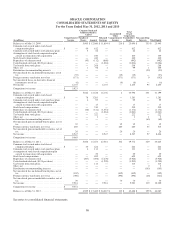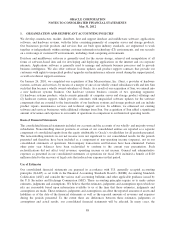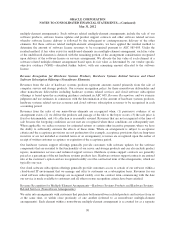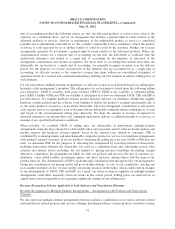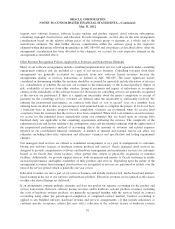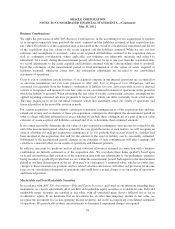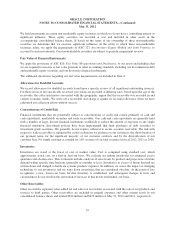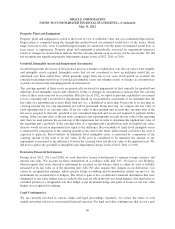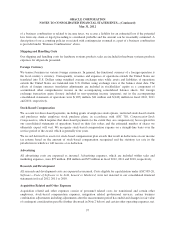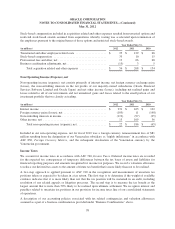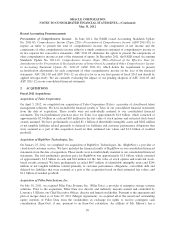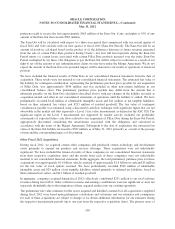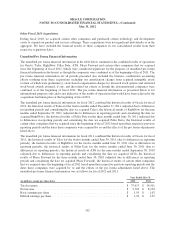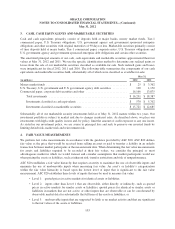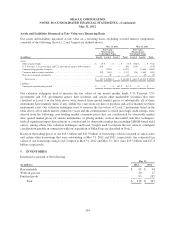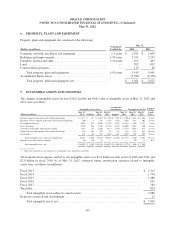Oracle 2012 Annual Report Download - page 100
Download and view the complete annual report
Please find page 100 of the 2012 Oracle annual report below. You can navigate through the pages in the report by either clicking on the pages listed below, or by using the keyword search tool below to find specific information within the annual report.ORACLE CORPORATION
NOTES TO CONSOLIDATED FINANCIAL STATEMENTS—(Continued)
May 31, 2012
Property, Plant and Equipment
Property, plant and equipment is stated at the lower of cost or realizable value, net of accumulated depreciation.
Depreciation is computed using the straight-line method based on estimated useful lives of the assets, which
range from one to fifty years. Leasehold improvements are amortized over the lesser of estimated useful lives or
lease terms, as appropriate. Property, plant and equipment is periodically reviewed for impairment whenever
events or changes in circumstances indicate that the carrying amount of an asset may not be recoverable. We did
not recognize any significant property impairment charges in fiscal 2012, 2011 or 2010.
Goodwill, Intangible Assets and Impairment Assessments
Goodwill represents the excess of the purchase price in a business combination over the fair value of net tangible
and intangible assets acquired. Intangible assets that are not considered to have an indefinite useful life are
amortized over their useful lives, which generally range from one to ten years. Each period we evaluate the
estimated remaining useful lives of purchased intangible assets and whether events or changes in circumstances
warrant a revision to the remaining periods of amortization.
The carrying amounts of these assets are periodically reviewed for impairment (at least annually for goodwill and
indefinite lived intangible assets) and whenever events or changes in circumstances indicate that the carrying
value of these assets may not be recoverable. Effective fiscal 2012, we opted to perform a qualitative assessment
to test a reporting unit’s goodwill for impairment. Based on our qualitative assessment, if we determine that the
fair value of a reporting unit is more likely than not (i.e., a likelihood of more than 50 percent) to be less than its
carrying amount, the two step impairment test will be performed. In the first step, we compare the fair value of
each reporting unit to its carrying value. If the fair value of the reporting unit exceeds the carrying value of the
net assets assigned to that unit, goodwill is not considered impaired and we are not required to perform further
testing. If the carrying value of the net assets assigned to the reporting unit exceeds the fair value of the reporting
unit, then we must perform the second step of the impairment test in order to determine the implied fair value of
the reporting unit’s goodwill. If the carrying value of a reporting unit’s goodwill exceeds its implied fair value,
then we would record an impairment loss equal to the difference. Recoverability of finite lived intangible assets
is measured by comparison of the carrying amount of the asset to the future undiscounted cash flows the asset is
expected to generate. Recoverability of indefinite lived intangible assets is measured by comparison of the
carrying amount of the asset to its fair value. If the asset is considered to be impaired, the amount of any
impairment is measured as the difference between the carrying value and the fair value of the impaired asset. We
did not recognize any goodwill or intangible asset impairment charges in fiscal 2012, 2011 or 2010.
Derivative Financial Instruments
During fiscal 2012, 2011 and 2010, we used derivative financial instruments to manage foreign currency and
interest rate risks. We account for these instruments in accordance with ASC 815, Derivatives and Hedging,
which requires that every derivative instrument be recorded on the balance sheet as either an asset or liability
measured at its fair value as of the reporting date. ASC 815 also requires that changes in our derivatives’ fair
values be recognized in earnings, unless specific hedge accounting and documentation criteria are met (i.e. the
instruments are accounted for as hedges). The offset to gain or loss on derivative financial instruments that were
designated as fair value hedges were recorded to the item for which the risk was being hedged. Any ineffective or
excluded portion of a designated cash flow hedge or net investment hedge and gains or losses on our fair value
hedges are recognized in earnings.
Legal Contingencies
We are currently involved in various claims and legal proceedings. Quarterly, we review the status of each
significant matter and assess our potential financial exposure. For legal and other contingencies that are not a part
96


